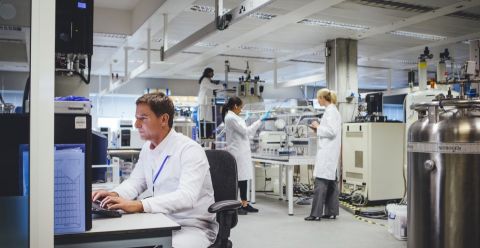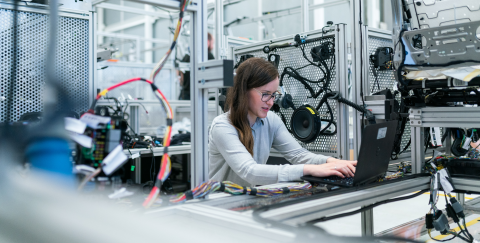The Advanced Research and Invention Agency: some initial reflections, and questions for policy makers
In February 2021, the UK Government announced the establishment of the Advanced Research and Invention Agency (ARIA). Drawing on the model of the US Advanced Research Projects Agency (ARPA) – now known as DARPA (D for defence) – ARIA is seen by the Government as a ‘new type of funding body’ tasked with supporting ambitious scientific research and breakthrough technologies, with a high tolerance to failure. ARIA is a mechanism to support the type of high risk, but potentially very high reward, research not considered possible within the existing research funding system. ARIA will contribute to the Government’s aim to position the UK as a ‘science superpower’, and deliver on its wider ambition to increase economy-wide investment in R&D to 2.4% of GDP by 2027.
The announcement has been anticipated for some time. Proposals for a ‘British ARPA’, were first set out in late-2019, and an £800m funding commitment was announced in July 2020 in the UK Research and Development Roadmap. This was confirmed in Budget 2021, followed by the introduction to Parliament of the Advanced Research and Invention Agency Bill in early-March. The Bill indicates that ARIA will be an independent agency, separate to UK Research and Innovation

What we know at this stage
Looking beyond the headlines on creating ‘science superpowers’ and seeking to mirror the success of DARPA in catalysing breakthrough inventions like the internet, GPS, developments in personal computing – and even Apple’s ubiquitous Siri virtual assistant – what do we know about ARIA at this point? Importantly, contrary to the suggestion of the House of Commons Science and Technology Committee, the Government has chosen not to task ARIA with delivering against pre-determined ‘challenges’ or ‘missions’. In turn, unlike DARPA, which is an agency of the Department of Defense and tasked with supporting innovation to enhance US military leadership – although its inventions often have much wider applications – ARIA will not be established to serve a ‘client’ such as a Government Department.
Rather, ARIA’s scientific and technology focus will be set independently, working to a broad remit to conduct, commission, and support activity that contributes to economic growth, promotes scientific innovation and invention, and improves quality of life in the UK (and elsewhere). Whilst in his evidence to the Science and Technology Committee on 17 March 2021 the Business Secretary Kwasi Kwarteng did indicate that the Government expects the upcoming Innovation Strategy to identify what he termed ‘tramlines’ for ARIA – that is, areas where the UK has comparative advantage and where the Government wants to see ‘dynamic innovation’ – the commitment to an independent scientific focus, set fundamentally by ARIA itself, appears to be strong.
Reflecting this ‘hands off’ approach in scientific focus, ARIA will have significant flexibility in what it can do, potentially drawing on a wider pool of innovators than would be the case otherwise, and creating a marketplace for ideas. Alongside offering grants, loans, and supporting prize-based innovation competitions, ARIA will be able to invest in existing companies, establish new companies and form/participate in partnerships and joint ventures, for the purposes of developing and exploiting scientific knowledge. ARIA will also be freed from standard procurement rules and personnel systems, enabling it to attract the ‘brightest and best’ to establish and enable the high-performance teams that will be central to its success. These high-performance teams will be characterised by low levels of bureaucracy, high levels of independence, strong connections between researchers and managers, and flexibility to select, fund and de-fund projects at pace.
Two further points of detail are (potentially) important. First, ARIA can continue to provide ‘technological input’ after any products emerging from its research have been commercialised, suggesting, in principle at least, that ARIA could generate direct financial returns from in-market products/services, and via acquisitions/IPOs. Second, ARIA is allowed to borrow money, which opens up the potential to access finance to support its activity from institutional lenders.
Some initial reflections …
Drawing on our experience at SQW Group evaluating research and innovation policies, supporting businesses to innovate and grow, and helping places to thrive, we offer four reflections on ARIA at this (early) stage.
First, engagement with the SME community will be key. SMEs can be both sources of new ideas and inspirations to inform the research agenda, and act as ‘performers’ (as termed by DARPA) providing the necessary solutions, problem-solving skills, and talent. However, reaching out to a wider pool of SMEs than traditionally engage with publicly-funded business support mechanisms will be essential, tapping into both formal and informal networks and groupings across the UK.
Second, whilst ARIA may be a new type of funding agency for the UK, there is much to be learned from wider ‘open innovation’ environments and approaches that have been implemented by R&D-intensive firms and other actors across the innovation landscape. This includes the benefits from enabling spontaneous connections and collisions between individuals from different disciplines and backgrounds; the development of communities of practice and interest around new opportunities; and the sharing of data and knowledge to address shared goals. Put simply, in our view it will be important that ARIA’s ambition is not limited to – solely – funding research in labs ‘behind closed doors’, but that it recognises the importance of the processes, ecosystems and environments within which invention and innovation happens.
Third, and linked to this, ARIA should consider how its funding can help to catalyse and crystallise innovation activity in particular places across the UK, consistent with the emerging R&D Places Strategy (anticipated later in 2021). This is not (in our view) about ARIA funding new facilities or research infrastructures, rather considering how it can best create, curate and animate the spaces, places and forums where inventors and innovators meet, share ideas, and collaborate. Crucially this should seek to align with existing and emerging ecosystems in prioritised areas, with ARIA funding acting as a magnet to others to exploit more fully these opportunities.
Fourth, even at this early stage, thought should be given to what ‘success’ looks like. Reflecting the anticipated time-paths to impact for high risk/high reward research, ARIA has been granted a 10-year grace period before its potential dissolution can be triggered by Parliament. It is possible that ARIA will lead to inventions that transform our society and economy like the internet, GPS (and yes, even Siri!). However, this is far from certain. In this context, it is perhaps worth reflecting that the central challenge for the UK is not in the quality or ambition of its science base – which are genuinely globally leading – but the diffusion and exploitation of new innovations across the business base. ARIA will not, and cannot, address this issue alone. However, in our view it can, and should, play an important role.

… and some key questions for policy makers
Anticipated to be fully operational by 2022, at this stage many questions naturally remain regarding ARIA's function and form. We think that three are particularly important for those tasked with progressing ARIA in the coming months:
- ARIA will touch on and perhaps benefit from synergy with many ingredients of the existing UK innovation landscape. This includes Innovate UK’s grant programmes and its Edge programme, university funding mechanisms including Quality Research funding (which is often used to support early-stage and risky research), and UKRI’s Industrial Strategy Challenge Fund, which involves an existing commitment of £2.6bn of public money to ‘address societal challenges.’ In this context, how can ARIA, and the Government, ensure that there is optimal synergy with existing research and innovation systems, capabilities, and funding mechanisms?
- ARIA investment could make a valuable contribution to the development of innovation capability in different parts of the UK, and perhaps particularly to those with weaker innovation assets. Yet much of the research capacity (in universities, research institutes, private labs) that may be best placed to respond to ARIA – initially at least – are located in the Greater South East. So, how can ARIA be most constructively deployed in aid of – and not contrary to – the Government’s ‘levelling-up’ agenda?
- The greater tolerance of risk and failure which is integral to ARIA may require a shift in attitudes across the UK’s research and innovation system (and, indeed the rest of society); but this will be a long-term process. In this context, how should the Government ensure that ARIA represents (and is seen to represent) value for money, and addresses a ‘business case’, whilst specifically focussing on areas with a greater tolerance of failure?
